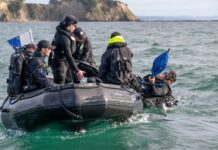
Man O’ War Station has lost its appeal against a land protection designation in a nationally significant case.
Last Friday, the Court of Appeal released its decision on Man O’ War Station’s appeal against an outstanding natural landscape classification over 1925 hectares of its land at the eastern end of Waiheke.
According to the decision, Man O’ War Station argued that Auckland Council had “set the bar too low” for properties meriting outstanding natural landscaping zoning.
Lawyers for Man O’ War Station argued that strict protection of the coastal environment has recently been imposed in outstanding landscapes and this would “impede the reasonable use and development of its land,” the decision states.
Auckland Council argued that the designation, which protects more than 80 percent of the 2364 hectare property from inappropriate development, should remain on the land and the Environmental Defence Society joined the opposition to the appeal.
The court found that the outstanding landscape classification is justified and ordered Man O’ War Station, which is owned by the Spencer family, to pay costs for the appeal to the council.
Environmental Defence Society chief executive Gary Taylor says the decision will have widespread effects on landscape protection in New Zealand.
If Man O’ War Station’s appeal had succeeded, the criteria for outstanding natural landscapes would have been pushed to a point that few, if any, Auckland or Waiheke landscapes would qualify.
“The Court of Appeal has now confirmed that the test for outstanding natural landscapes should remain the same. It rejected all Man O’ War’s arguments,” says Mr Taylor.
Waiheke Local Board granted $3000 to the Environmental Defence Society to help cover the costs of lawyers Rob Enright and Madeleine Wright, who donated time to represent the society in the case.
Mr Enright also represented the society in a Supreme Court case against King Salmon that established in 2014 that outstanding landscapes must be protected from adverse effects.
Mr Taylor says it would have been “perverse” if winning more robust controls on outstanding landscapes had led to reducing the areas that merit protection under New Zealand law.
“The outcome in this case reinforces the Supreme Court decision. It will have implications nationally including, ironically, for King Salmon, which is seeking to expand salmon farming in outstanding natural landscapes in the Marlborough Sounds.
“We’d like to thank Auckland Council for its role in defending the Waiheke coastline,” says Mr Taylor.
An outstanding natural landscape zoning provides “quite a strong level of protection” against inappropriate development, says Mr Taylor.
He would like to see more work done to protect Man O’ War Station, as either private or public land, into the future.
“This win is not the end of the story.
“The future of Man O’ War Station needs careful strategic thought, because it’s such a big property with such outstanding natural landscape values.
“I would be interested in talking with the council and the land owner about the long term future of the property and what we can do to ensure its conservation values are protected,” he says.
Despite many years of court battles to allow development of the property, Mr Taylor says the landowners have done a “good job of protecting it over many decades” and could be open to ideas for future protection.
The Court of Appeal hearing follows the High Court rejecting Man O’ War Station’s appeal in April 2015 over the outstanding natural landscape classification.
The High Court upheld a 2014 Environment Court decision, which rejected the landowner’s submission that only coastal and specific inland areas should be covered by the classification.
The property owners argued that the land had been “so heavily developed that it cannot properly be described as ‘natural’ ”.
However, the Environment Court stated “it became obvious to us that [Man O’ War’s] property on Waiheke Island offered a mosaic of landscape features including the bush clad eastern slopes of the Puke range, an interspersed network of bush gullies, pastureland, vineyards, and geological features, flanked by a series of coastal headlands, escarpments and ridges leading out to the waters of the Hauraki Gulf.
“These features interact in a manner that, viewed from either land or sea, makes it difficult to identify separate landscapes for assessment of significance […] we do not find it appropriate to separate the coastal and inland landscape.”
Man O’ War Station stretches from Cactus Bay around the coast to Man O’ War Bay and is used for wine and olive growing and for other rural purposes.
Despite the contested outstanding natural landscape designation, the owners have gained consent to build two houses on the land.
In December 2014, the Environment Court granted resource consent for amended plans for a 193 square-metre house about 40 metres from the beach at Owhiti Bay. Auckland Council has also granted building consent for the Owhiti Bay house.
After drawn out legal battles, Man O’ War Station also obtained resource consent to build a house at least 40 metres from the beach at Cactus Bay, with a floor area of 181 square metres and a roof area of 356 square metres. • Rose Davis






